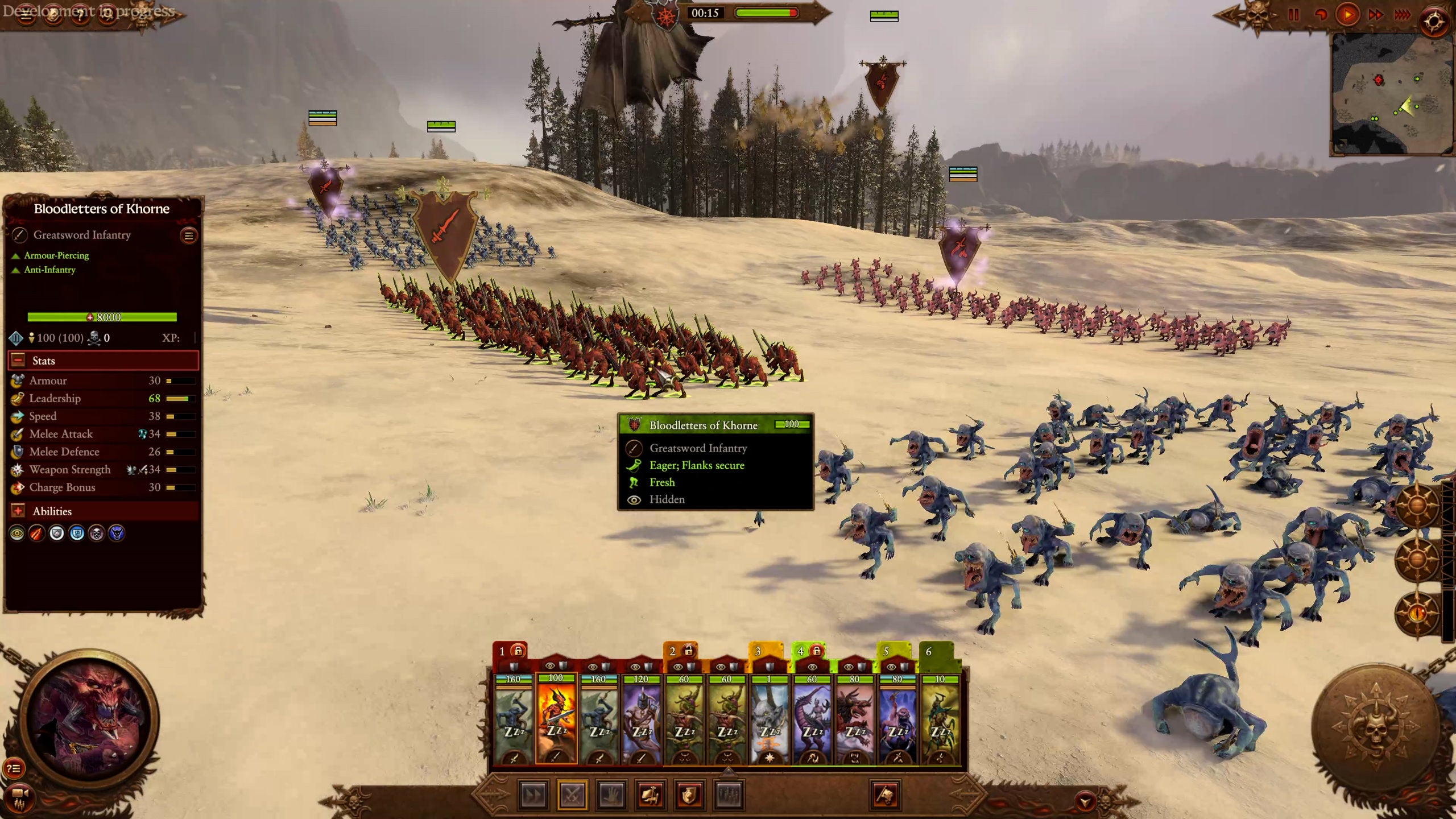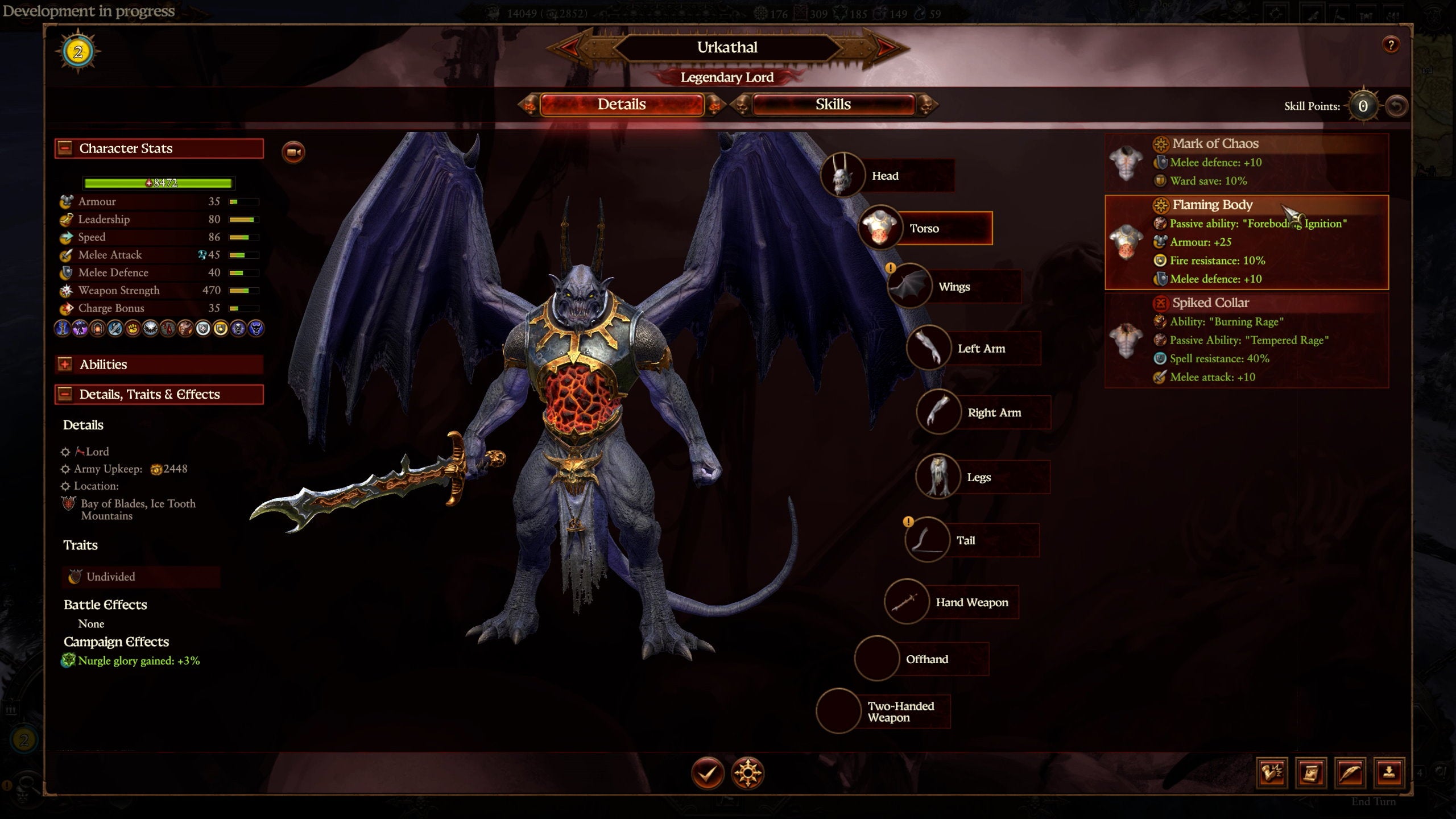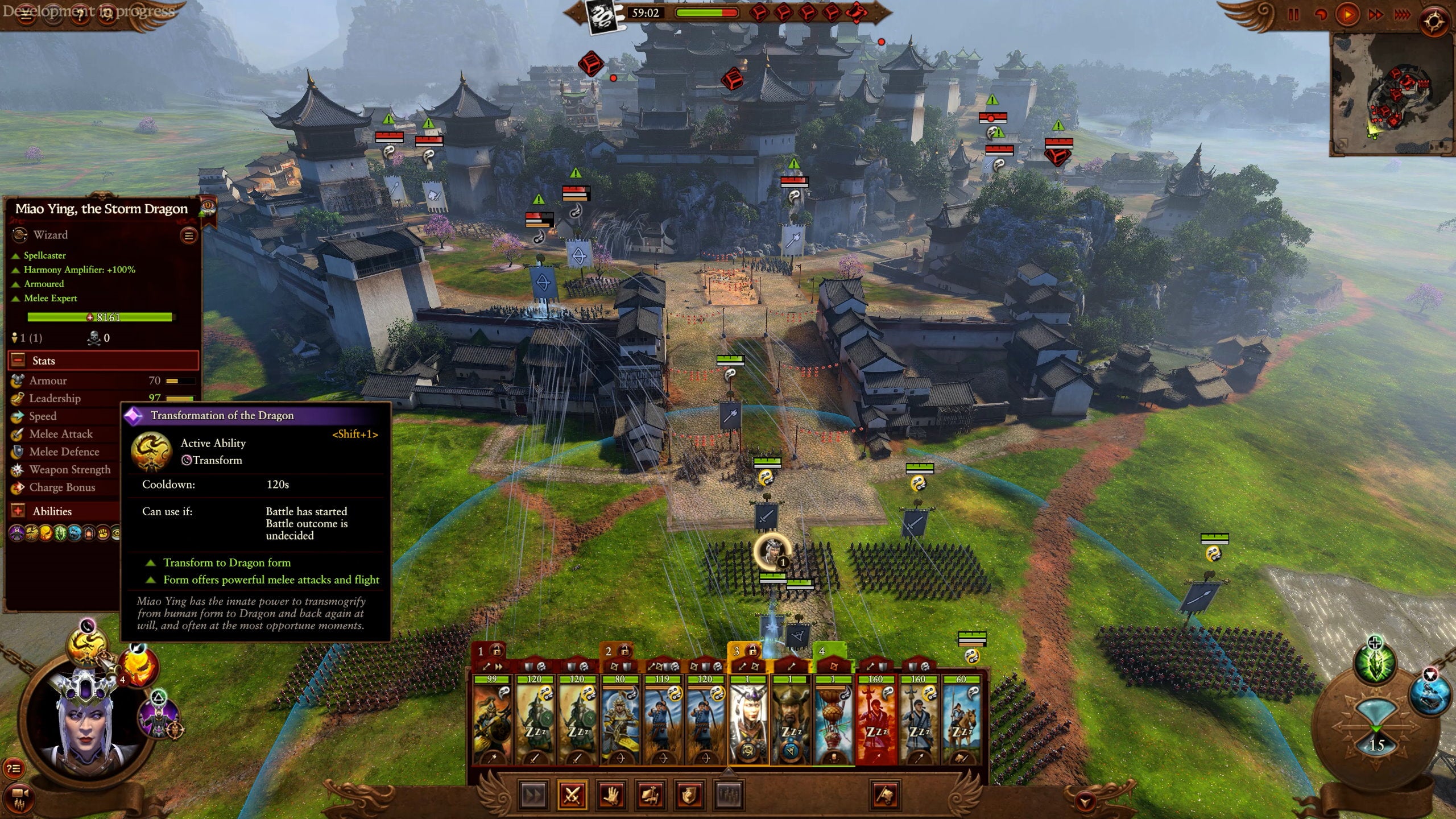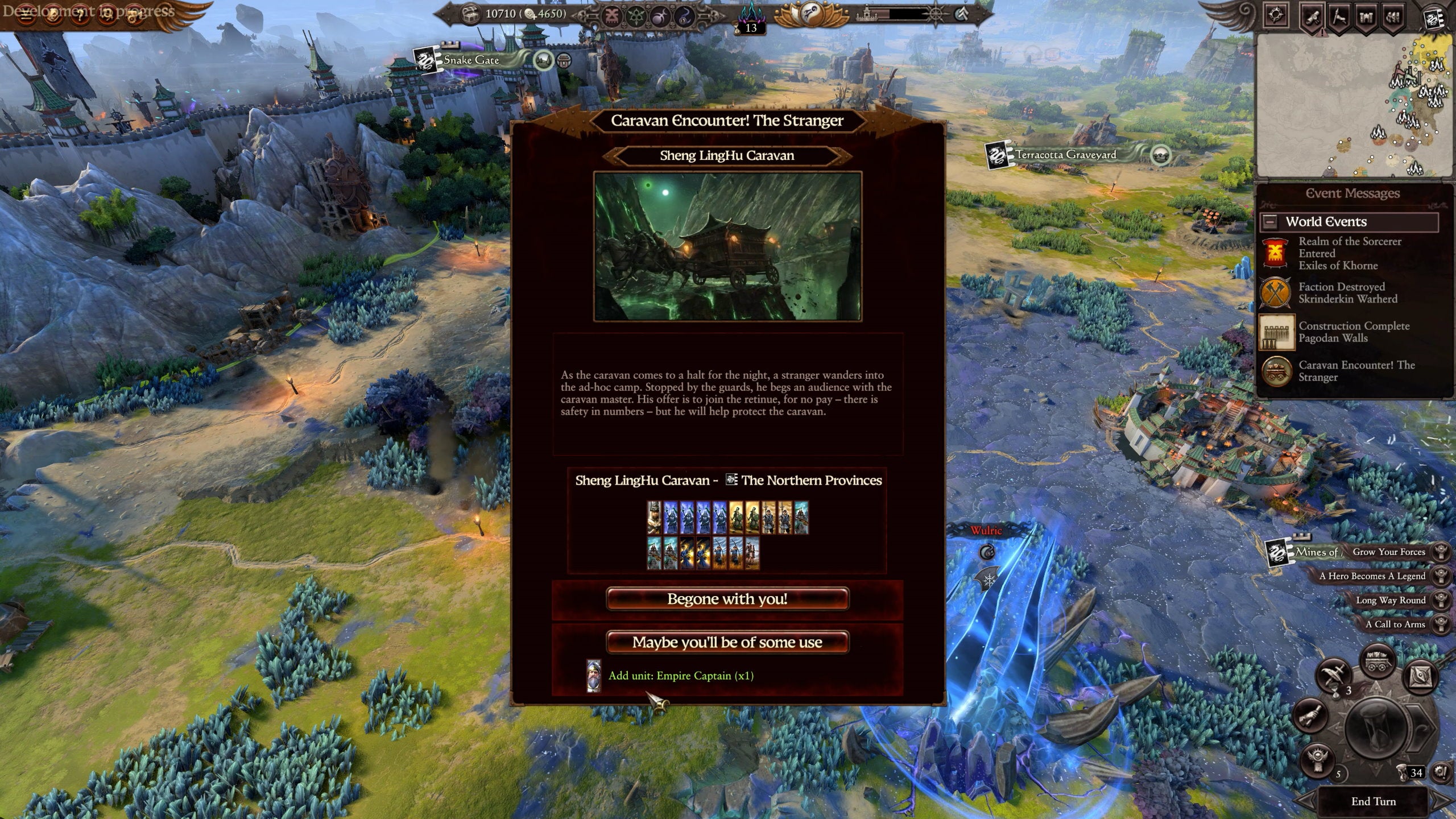In a recent hands-on event, I was able to play something like eight hours worth of this final game in the trilogy from the comfort of my own spare room. Having not done a “digital preview” before now, this was something of a revelation to me. Wearing my comfortable clothes and with a steady supply of big mugs of tea, I booted up the game, hit ‘New Campaign’ and was greeted with the following screen. Eagled-eyed readers will have spotted an eighth, as-yet-unannounced faction here called the Daemons of Chaos. I’m assuming they’ve just been announced as this article was published? If not, wow, what a scoop! Unlike the other four playable Chaos factions, the Daemons of Chaos are a sort of hybrid thing that has players courting each of the Ruinous Powers in turn and in doing so, gaining access to buildings and units from across their grotesque rosters. Led by a scorned Daemon Prince, this faction is meant to be played like you’re rummaging around in a pick ’n’ mix, but instead of loading up on foam bananas and jelly babies, you’re recruiting Nurglings and Bloodletters of Khorne into the same army. The same army! Now that’s pretty chaotic alright. Everything you accomplish on the campaign map from winning battles, to looting settlements, to leveling up your extremely furious Prince, gives you the opportunity to earn favour with at least one of the four gods. And the more they like you, the better the goodies you’ll be able to unlock. This faction is all about synergy, then. How do different units from different factions compliment one another in battle? What playstyles does that encourage? Is this actually any more fun than just sticking with a single, more intentional roster? And to be honest, I can’t answer any of those questions just yet. I haven’t played any of the other four Chaos factions on their own yet, let alone making sense of this mix and match approach. It seems interesting though! I do want to mention one other Daemons of Chaos feature that I absolutely loved right off the bat. As well as unlocking different buildings and units, pleasing each of the Chaos gods also gives your Daemon Prince access to a wide variety of new body parts to choose from. These come with all sorts of different traits and abilities to better focus your lord’s playstyle in battle, but it’ll also mean that they’ll start to take on the aesthetic of their preferred god as well. Dedicate your life to Nurgle, for example, and you might find your prince is now sporting a second mouth where his belly button used to be. Big fan of this. With all that being said, the Daemons of Chaos somewhat paled in comparison to the other faction I was able to muck around with. You’re unlikely to have spotted this one in your local Games Workshop however, as it’s only really referenced in the more obscure, dust-covered tomes of Warhammer Fantasy lore. Having been fleshed out with this very game in mind, the Grand Cathay faction is the result of a more direct collaboration between Creative Assembly and Games Workshop, we’re told. Based loosely on Chinese mythology, Grand Cathay is the home of celestial dragons, terracotta giants and the harmonic forces of Yin and Yang. I’ve got to say, as much as I enjoyed the mechanics at play here (and I really really did), I don’t think I ever stopped being aware that I was playing a Western studio’s take on Eastern culture. Whereas Total War: Three Kingdoms had such clear source material to rely upon, this faction definitely feels like it was created by a team on the other side of the world. I’d love to hear some Chinese takes on this, frankly. Playing as Mao Ying, the Storm Dragon, I was tasked with defending the Great Bastion, a gigantic wall separating the natural world from the sprawling Chaos Wastes beyond. As the campaign progresses, a bar at the top of your screen shows the current level of Chaos forces massing on the other side and once it’s filled, a great invasion is launched. The Grand Cathay people are then tasked with manning the wall’s four hefty gates and repelling any attack from breaking through. My time with the game only saw one invasion happen and the Chaos armies actually ended up attacking a gate held by an AI-controlled Grand Cathay faction, so I didn’t get to see one of these dramatic sieges in action, but they certainly sound high stakes. In between bouts of protecting the entire world from destruction, I’d use whatever downtime I could to expand on the safe side of our wall and then shore up my borders. Although I never felt comfortable pushing too far, as I didn’t want to find myself several turns away from the gate I was meant to be defending mid-invasion. Thankfully, there was another way to bolster my coffers without taking that particular risk and it’s entirely unique to this faction. It’s also totally brilliant. Grand Cathay has the option to send out caravans to trade with other cities using a system called The Ivory Road. Each caravan is essentially an army in its own right, although the units it’ll have at its disposal are somewhat pre-decided, at least to begin with. After hiring a Caravan Master and piling them up with supplies, you point them towards some far away city and each turn they’ll move towards it as quickly as possible. If the territory they need to cross is under friendly control, perhaps they’ll arrive unscathed, but to get the biggest payday you’ll likely want to take more of a risk. And so, while you’re dealing with the latest invasion of the Grand Bastion or trying to expand your territory, your caravan will quietly be pottering its way across the world map in the background. Occasionally you’ll need to take control in order to defend it from attack or decide whether to pay a certain amount of gold to take advantage of a shortcut and escape danger. There’s something really appealing about the fact that you can’t just manually recruit units to these caravans like you might with a typical army and so losing anything in a battle feels especially painful. In fact, as far as I could tell, the only way to introduce new forces into your caravan is via the Choose Your Own Adventure style events that pop up from time to time. This might see you grabbing a couple of units of crossbowmen, or perhaps some cavalry, but it can also mean recruiting heroes from entirely different factions too. As a result, I found myself just as invested in the successes and failures of these caravans as I did in my primary force on the campaign map. I think this might be one of my favourite faction-specific systems across the entire trilogy, to be honest. It’s such an intriguing thing to have ticking away in the background in between turns of a more defensive campaign focused more solely on the Great Bastion and its gates. There’s also a ton of promising changes for those who’ve played the previous Total Warhammer games too, including a reworked diplomacy system that allows factions to trade settlements and build outposts in one another’s cities. Sieges seem like they’ve been improved too, with new capture points that knock out nearby towers rather than having players pick them off one by one. And sure, just like Nate (RPS in peace) mentioned in his earlier preview, Warhammer 3’s Survival Mode battles are Total War at perhaps its most arcadey. But they’re also great and a superb change of pace to mark the various milestones you’ll hit across a campaign. Having played more than my fill of the previous two games, thanks to a near constant drip feed of new stuff to totally war, I can’t believe how excited I am by this next iteration. The Creative Assembly have only gone and done it again.





